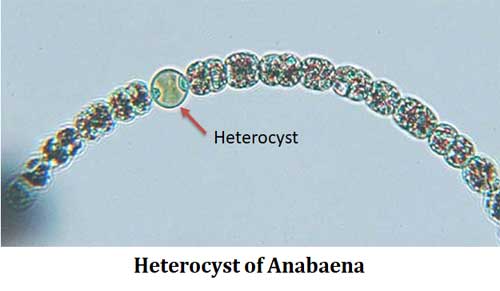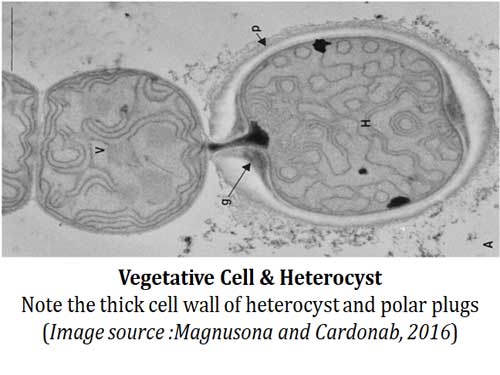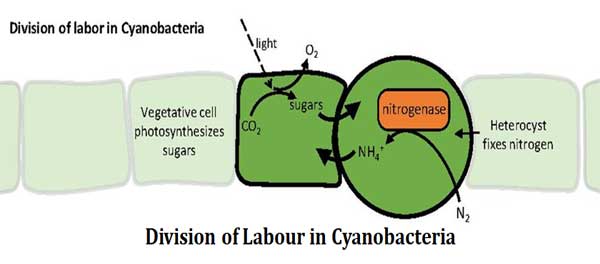Learning Objectives: What are Heterocysts? Structure of Heterocyst, Development of Heterocyst, Functions of Heterocyst, Mechanism of Nitrogen Fixation in the Heterocyst.
In the previous post, we discussed the General Characteristics of Cyanobacteria and the Structure of Carboxysomes. Here we will see the Structure and Functions of Heterocyst – a unique cell in some Cyanobacteria which perform nitrogen fixation. Your are also requested to visit our Microbiology and Botany Short Notes Pages.
What are Heterocysts?
Ø Heterocysts are specialized nitrogen-fixing cells in certain filamentous Cyanobacteria or Blue Green Algae (BGA) such as Nostoc, Anabaena and Cylindrospermum.
Ø Heterocyst of cyanobacteria is a unique structure with unique properties and they are quite distinguishable from the vegetative cells.
Ø Heterocysts are usually round and larger in shape than vegetative cells.
Function of Heterocyst
Ø The main function of heterocyst is nitrogen fixation.
Ø Heterocysts can fix nitrogen from dinitrogen (N2, atmospheric nitrogen) in the air using the enzyme nitrogenase to nitrates and nitrites.
Ø The nitrogenase enzyme is inactivated by molecular oxygen (O2).
| You may also like NOTES in... | ||
|---|---|---|
| BOTANY | BIOCHEMISTRY | MOL. BIOLOGY |
| ZOOLOGY | MICROBIOLOGY | BIOSTATISTICS |
| ECOLOGY | IMMUNOLOGY | BIOTECHNOLOGY |
| GENETICS | EMBRYOLOGY | PHYSIOLOGY |
| EVOLUTION | BIOPHYSICS | BIOINFORMATICS |
Ø Heterocyst helps to create a micro-anaerobic environment for the functioning of nitrogenase enzyme to fix the atmospheric nitrogen.
Ø Heterocysts are formed during nitrogen starvation by some Cyanobacteria.
Ø Around 5 to 10% of the cells can develop into heterocysts when cyanobacteria are deprived of both nitrate and ammonia.
Heterocysts vs Vegetative Cells
Ø When compared to vegetative cells, heterocysts are with less granular cytoplasm, diminished pigmentation, thickened cell walls and refractile polar bodies at the points of attachment to neighbouring vegetative cells.
Unique Features of Heterocysts
Ø Heterocysts are very unique cells and some of these unique features are discussed below:
Ø Heterocysts show global changes in the expression of their genes.
Ø They can produce nitrogenase and other proteins involved in nitrogen fixation.
Ø Heterocysts produce three additional cell walls, including one of glycolipid that forms a hydrophobic barrier to oxygen.
Ø Heterocysts can also produce proteins that scavenge any remaining oxygen.
Ø Heterocyst degrades the photosystem II of photosynthesis (which produces oxygen) so that an oxygen-free environment can be ensured.
Ø The lack of water-splitting in photosystem II prevents heterocysts from performing photosynthesis.
Ø Heterocysts maintain photosystem I, allowing them to generate ATP by cyclic photophosphorylation.
Ø They can up-regulate the glycolytic enzymes.
Ø They contain polar plugs composed of cyanophycin which slows down cell-to-cell diffusion of oxygen.
Ø There will be two polar bodies in intercalary heterocysts but one in the terminal heterocysts.
Ø The polar bodies are composed of Cyanophycean granules.
Ø Cyanophycean granules are nitrogen reserves specific to cyanobacteria. They are composed of polymers of amino acids such as arginine, aspartic acid and glutamic acid.
Ø Cyanobacteria obtain fixed carbon (carbohydrate) by photosynthesis.
Ø The heterocysts also lack RuBisCO and the Calvin cycle enzymes so CO2 fixation is limited to the vegetative cells.
Ø Thus, the vegetative cells provide them with carbohydrates, which is thought to be sucrose or maltose.
Ø The fixed carbon and nitrogen sources are exchanged through channels between the cells in the filament.
Ø Thus, the structure and physiology of the heterocyst ensures that it will remain anaerobic and is dedicated to nitrogen fixation.
Ø Heterocysts provide fixed nitrogen to vegetative cells in the form of amino acid glutamine.
Development of Heterocyst
Ø Cyanobacteria have a Gram-negative cell wall that includes two distinct membranes, the plasma membrane and an outer membrane, and a peptidoglycan layer.
Ø The peptidoglycan layer in cyanobacteria is thicker than that in other Gram-negative bacteria.
Ø External to the cell wall there is a carbohydrate-enriched glycocalyx which is again differentiated into three recognizable layers: (i). a closely associated sheath, (ii). a defined capsule, and (iii). loosely associated slime.
Ø These layers protect the cells from desiccation and presumably from phages (cyanophages) and predators.
Ø The heterocyst is differentiated from a vegetative cell.
Ø Single heterocysts develop about every 9-15 cells, producing a one-dimensional pattern along the filament.
Ø The interval between heterocysts remains approximately constant even though the cells in the filament are dividing.
Ø The heterocyst development begins with sensing the deficiency of nitrates and the process is completed in about 20 hours.
Ø Gene expression studies show that there is a global change in the gene expression pattern which ultimately results in the transformation of a vegetative cell to a heterocyst.
Ø Heterocyst formation is inhibited by the presence of a fixed nitrogen source, such as ammonium or nitrate.
| You may also like... | ||
|---|---|---|
| NOTES | QUESTION BANK | COMPETITIVE EXAMS. |
| PPTs | UNIVERSITY EXAMS | DIFFERENCE BETWEEN.. |
| MCQs | PLUS ONE BIOLOGY | NEWS & JOBS |
| MOCK TESTS | PLUS TWO BIOLOGY | PRACTICAL |
Heterocyst: as an origin of multicellularity and labour division
Ø The cyanophycean filament can be seen as a multicellular organism with two distinct yet interdependent cell types.
Ø Such behavior is highly unusual in prokaryotes and may have been the first example of multicellular patterning in evolution.
Ø Once a heterocyst has formed it cannot revert to a vegetative cell.
Ø The senescent heterocyst undergoes vacuolation and finally breaks off from the filament causing fragmentation. These fragments are called hormogonia (singular hormogonium) and undergo asexual reproduction.
Ø Certain heterocyst-forming bacteria can differentiate into spore-like cells called akinetes making heterocysts the most phenotypically versatile of all prokaryotes.
Reference:
Ø https://en.wikipedia.org/wiki/Heterocyst
Ø Kumar K, Mella-Herrera RA, Golden JW. Cyanobacterial heterocysts. Cold Spring Harb Perspect Biol. 2010
If you Like this Post, I Would Like to Hear it from You… Please COMMENT . . . . (below ↓)
You may also like.
@. Cyanobacteria- Characteristics
@. Carboxysomes
More Lecture Notes from Easy Biology Class…
Botany|Zoology|Biochemistry|Genetics|Cell & Molecular Biology|Biotechnology|Physiology & Endocrinology|Plant Physiology|Microbiology|Immunology|Embryology|Ecology|Evolution|Biophysics|Research Methodology|Biostatistics|Chemistry for Biologists|Physics for Biologists
Browse more in Easy Biology Class…
Lecture Notes|Biology PPTs|Video Tutorials|Biology MCQ|Question Bank|Difference between|Practical Aids|Mock Tests (Online)|Biology Exams



